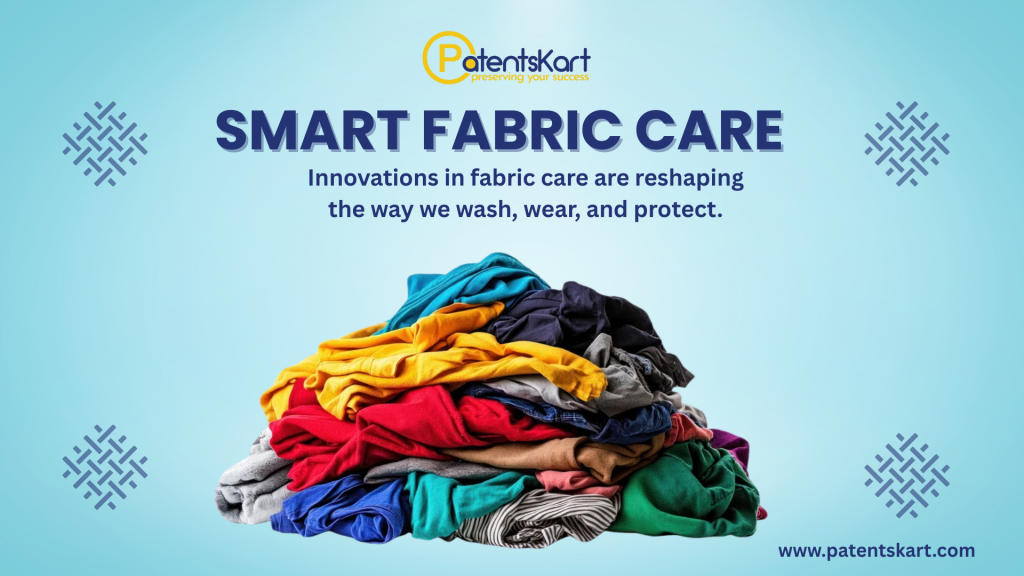What Is Fabric Care Technology and Why Is It So Important in 2025?
Fabric care technology involves innovations that improve the maintenance, cleanliness, durability, and performance of textiles. In 2025, it plays a crucial role in sustainability, smart clothing, and advanced consumer care—driven by new coatings, sensors, and AI-powered applications.
This technology supports longer fabric life, reduces environmental damage, and empowers both industries and consumers with high-efficiency solutions.
What Types of Innovations Are Shaping Fabric Care Technology?
Energy-Efficient Laundry Solutions
New fabric technologies support cold-wash and quick-dry capabilities. This reduces electricity and water usage, making laundry practices more energy-efficient and eco-conscious—particularly important for both household and industrial applications.
Smart Textiles
These fabrics are embedded with sensors and electronics that allow them to react to environmental changes or user movement. They bring added functionality such as temperature regulation, motion detection, or moisture response—pushing the boundaries of traditional fabric use.
Functional Coatings
Innovations like hydrophobic, antimicrobial, and self-cleaning coatings improve fabric performance. These coatings help repel liquids, prevent odor-causing bacteria, and reduce the frequency of washing—extending garment life and improving hygiene.
Eco-Friendly Detergents
The use of biodegradable and enzyme-based detergents supports sustainability in fabric care. These formulas are gentle on textiles, effectively remove stains, and reduce the environmental footprint compared to conventional chemical-based detergents.
Fragrance Delivery Technologies
Techniques such as microencapsulation allow controlled, long-lasting scent release. This ensures that fabrics maintain a fresh aroma over time, enhancing user experience without relying on strong chemical perfumes.
What Are the Most Promising Applications of Fabric Care Technology?
- Apparel & Fashion
Fabric care innovations in this sector enable garments to be wrinkle-free, odor-resistant, and even self-cleaning, reducing maintenance and extending wearability. These features improve user convenience and help maintain the quality and appearance of clothing over time. - Healthcare Textiles
Antiviral and antibacterial treatments are being applied to hospital uniforms, beddings, and linens to enhance hygiene and infection control. These innovations are critical for ensuring patient and staff safety in clinical environments. - Sportswear & Activewear
Advanced fabrics offer sweat-wicking, breathable, and anti-odor properties that keep athletes comfortable and dry. This improves performance, reduces skin irritation, and supports better hygiene during physical activity. - Home Furnishings
Items like curtains, sofas, and bedsheets are now made with stain-resistant treatments, making them easier to clean and maintain. These features are especially valuable in homes with children or pets, where spills and stains are frequent. - Industrial Laundry Systems
Innovations in automation and process optimization are helping large-scale laundry services reduce water usage, energy consumption, and detergent waste. These improvements not only lower operational costs but also contribute to environmental sustainability.
Which Companies Are Leading the Way in Fabric Care Technology?
| Company | Notable Innovation |
| Procter & Gamble | Sensor-based washing recommendations and AI-driven fabric care |
| Unilever | Biodegradable, low-temperature laundry formulations |
| Dow Chemical | Durable water-repellent (DWR) and antimicrobial coating solutions |
| Kao Corporation | Smart fragrance delivery systems in laundry products |
| LG Electronics | AI-enhanced washers that optimize wash cycles for fabric protection |
What Universities and Labs Are Driving Fabric Care Research?
- North Carolina State University (USA) – Smart textiles and textile engineering
- University of Leeds (UK) – Sustainable laundry systems
- IIT Delhi (India) – Antimicrobial and nanofiber coatings
- ETH Zurich (Switzerland) – Fabric electronics and wearable sensors
- Yonsei University (South Korea) – High-performance fabric surface modifications
How Is Fabric Care Technology Helping the Environment?
- Reduces Water & Energy Use: Smart washing technologies lower environmental impact
- Supports Longevity: Extends life of clothes, reducing textile waste
- Eco-Friendly Materials: Promotes use of green surfactants and enzyme-based cleaners
- Biodegradable Innovations: Enhances end-of-life recyclability of fabric products
What Are the Current Challenges in Fabric Care Technology?
| Challenge | Impact and Explanation |
| Material Compatibility | Ensuring coatings and detergents work across various textile types |
| Consumer Adoption | Educating users about benefits and correct usage |
| Regulatory Compliance | Meeting environmental and safety standards |
| Cost of Innovation | Balancing high-tech features with affordability |
| Long-Term Durability | Maintaining functionality after multiple wash cycles |
What Industry Standards and Certifications Matter in Fabric Care?
| Standard / Certification | Purpose |
| ISO 6330 | Domestic washing and drying procedures |
| OEKO-TEX® | Textile safety and sustainability certification |
| ASTM D6544 & D6775 | Durability and wrinkle-resistance testing |
| EPA Safer Choice | Certification for eco-friendly household products |
What Is the Market Outlook for Fabric Care Technology?
| Period | Trend and Growth Forecast |
| 2025–2030 | Surge in smart textiles and antimicrobial home products |
| 2030–2040 | Global mainstreaming of biodegradable and AI-enhanced laundry solutions |
| Beyond 2040 | Fully autonomous textile maintenance and closed-loop fabric care systems |
How Can PatentsKart Help You Lead in Fabric Care Innovation?
PatentsKart offers IP support to innovators, manufacturers, and startups shaping the future of fabric care:
- Patent Landscape Analysis – Explore trends and identify white spaces
- FTO and Risk Assessment – Ensure compliance and avoid infringement
- IP Filing & Strategy – Draft, file, and prosecute patents globally
- Competitor & Tech Watch – Monitor market movement and emerging leaders
With PatentsKart, your smart textile or fabric care innovation is protected, scalable, and future-ready.
FAQs on Fabric Care Technology
-
What is fabric care technology?
It refers to advanced materials, processes, and products designed to maintain and enhance textile quality and hygiene.
-
Are smart fabrics washable?
Yes, many are engineered to withstand washing, though care instructions vary by technology.
-
Is fabric care technology eco-friendly?
Modern innovations prioritize biodegradability, low energy use, and sustainable chemicals.
-
Can coatings make clothes self-cleaning?
Yes, some hydrophobic and photocatalytic coatings reduce the need for frequent washing.
-
How do I protect my innovation in fabric care?
Partner with PatentsKart to analyze the market, file patents, and develop a strong IP strategy.
Recent Blogs by PatentsKart
- How Carbon Utilization in Chemicals Is Changing Clean Manufacturing
- AI in Telemedicine: Shaping the Future of Remote Healthcare
- Biometric Blockchain Wallets: Next-Gen Web3 Security
Conclusion: Is Fabric Care Technology the Future of Sustainable Textiles?
Absolutely. Fabric care technology is reshaping how we interact with our clothing, home textiles, and cleaning systems. From self-cleaning shirts to AI-powered washers, the innovation surge is undeniable.
As the world seeks smarter and greener textile solutions, businesses leading the way must protect their breakthroughs. PatentsKart is your partner in securing innovation and maximizing market impact.
Ready to patent your fabric care breakthrough? Contact PatentsKart today.







